Part 2 – Automotive Quality Standards 101: What Qualification Really Gets You
March 6, 2025
In our 2018 article, Automotive Quality Standards 101: What Qualification Really Gets You, we explored the automotive quality standards at that time. Since then, the automotive market has advanced significantly, with electronics playing a larger role in and around vehicles. This article revisits and provides updates to the topic, highlighting new standards shaped by next-generation automotive electronics and communication technologies.
Modern and Next-Gen Vehicles
Designing modern automobiles is an incredibly complex task. Today’s vehicles are more than just machines; they are sophisticated electronic ecosystems with up to 100 programmable Electronic Control Units (ECUs) and as many as 100 million lines of code. These systems manage everything from the engine and powertrain to infotainment, communications and safety features. As automotive technology advances toward more sophisticated driver-assistance systems and autonomous driving, the complexity of vehicle design continues to grow.
A major shift in this evolution is the transition to software-defined vehicles (SDVs), where software, rather than hardware, dictates vehicle functionality. Unlike traditional vehicles built around mechanical frameworks, SDVs operate more like smartphones—constantly evolving through software updates rather than requiring hardware modifications or new models. This software-driven transformation is a significant milestone in the automotive industry, paving the way for future advancements, including fully autonomous vehicles (AVs). These SDV systems use sophisticated power management integrated circuits (PMICs), motor control devices (MCDs) and wireless communication systems like those shown in Figure 1.
These SVD vehicles are cloud-connected, enabling seamless digital interaction with their environment and over-the-air updates, allowing software enhancements without hardware modifications. Designed around a software-driven architecture, SDVs integrate features such as infotainment systems, digital cockpits and advanced vehicle controls. This approach makes SDVs highly adaptable, continuously evolving with new capabilities, intelligent, with upgrades throughout their lifecycle and connected..
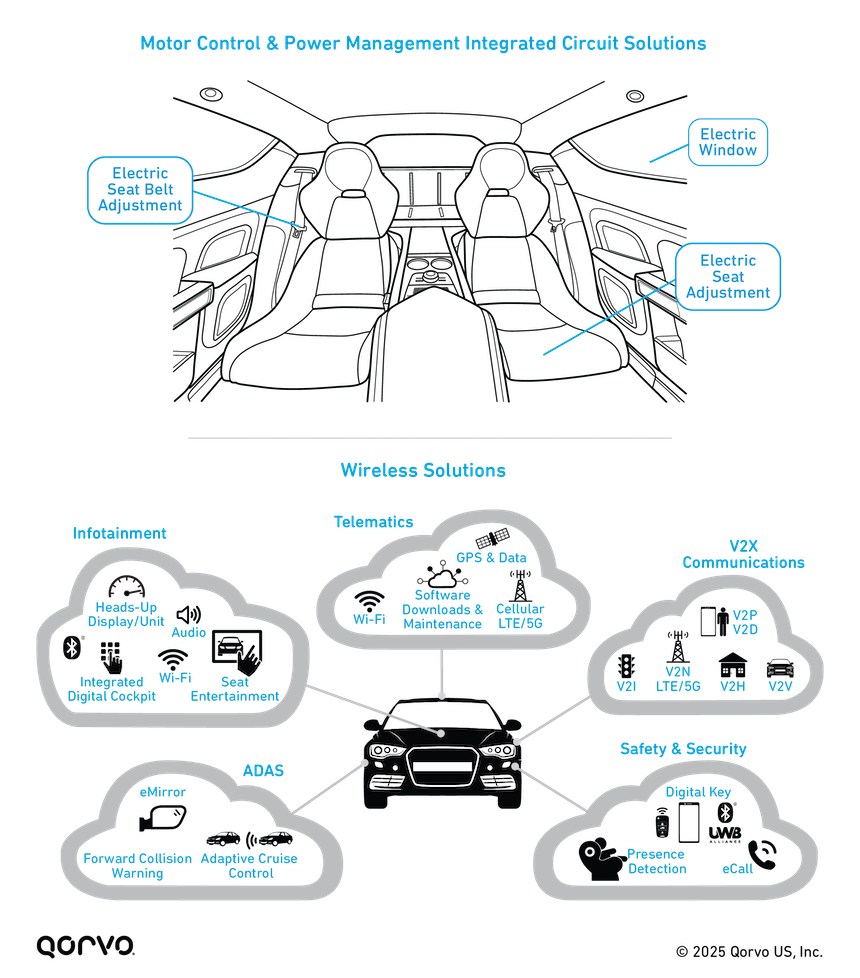
The automotive sector is now the fastest-growing market for electronic systems, making high-quality components more critical than ever. Different industries—consumer, military, industrial, and automotive—have varying requirements based on their applications. This article compares the automotive and consumer markets, highlighting key differences in qualification standards. While most consumer electronics require less rigorous testing – certain consumer-based products, like refrigerators and washers, demand higher standards than mobile phones. As shown in the table below, some electronic components in consumer goods have lower life expectancy, temperature compliance and durability compared to those in automobiles.
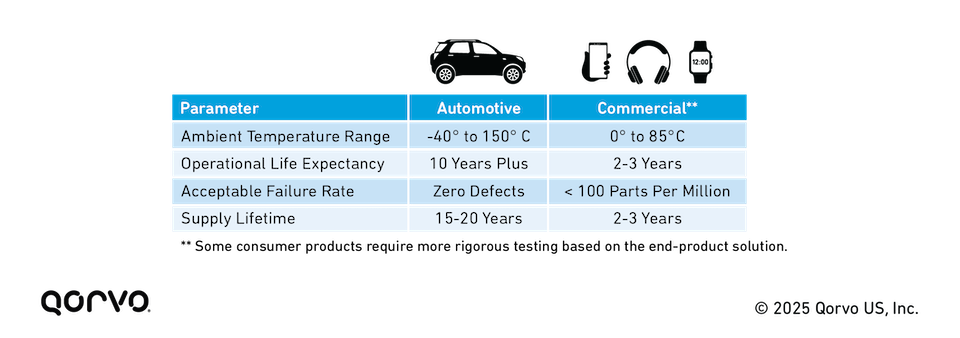
Critical Design Factors for Automotive Electronics
As vehicle electronics become more complex and control an increasing number of functions, several key design factors must be considered:
- Ruggedness and Reliability: Automotive components must endure the harsh conditions of everyday use, including extreme temperatures, humidity, and mechanical stress.
- Longevity: Unlike consumer electronics, vehicles are expected to function reliably for ten years or more. This longevity demands that every component be built to last.
- Interference: The numerous electronic systems within a vehicle must coexist without causing electromagnetic and RF signal interference, which could disrupt the performance of critical functions.
To ensure these factors are adequately addressed, the automotive industry has established strict quality standards for component manufacturing and testing. Only parts that meet these standards can be qualified for automotive use, ensuring they do not fail once embedded in a vehicle's electronic systems.
Key Automotive Quality Standards
For a component to be considered "automotive qualified," manufacturers must adhere to several industry standards throughout the production and testing process. IATF 16949 is an international standard for automotive quality management systems developed by the International Automotive Task Force (IATF), and is applicable to organizations manufacturing parts, assemblies and components for the automotive industry. The standard aims to develop a quality management system that emphasizes continual improvement and defect prevention. It also focuses on reducing waste and supply chain variation while efficiently meeting customer requirements and enhancing customer satisfaction. It is based on ISO 9001 but includes additional customer-specific requirements for each automaker. The standard is grounded in seven quality management principles: customer focus, leadership, engagement of people, process approach, improvement, evidence-based decision making and relationship management.
The Automotive Electronics Council (AEC) is an organization originally established in the 1990s by Chrysler, Ford and GM to establish common part-qualification and quality-system standards. The AEC Component Technical Committee is the standardization body for establishing standards for reliable, high-quality electronic components. As shown below, several AEC standards have been outlined for the automotive sector. Components meeting the specifications below are suitable for use in the harsh automotive environment without additional component-level qualification testing.
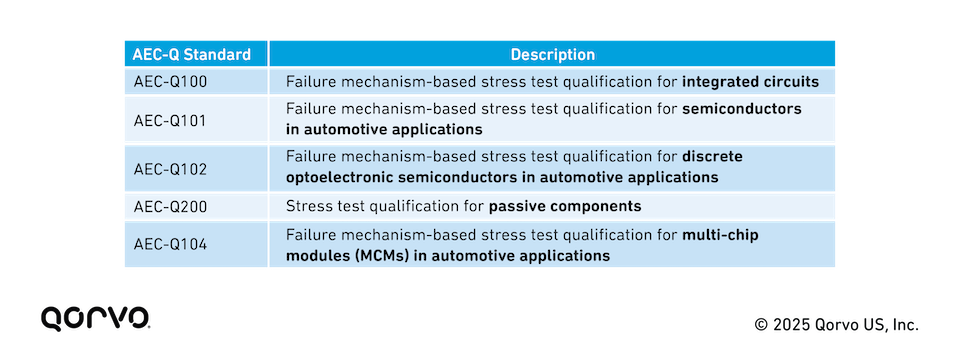
Testing for Automotive Qualification
Automotive components undergo testing at various stages of the production process, from wafer level to the finished product:
- Wafer Level and Assembly: Each die receives multiple optical inspections to detect any defects that could lead to failure once the components are integrated into vehicle systems. .
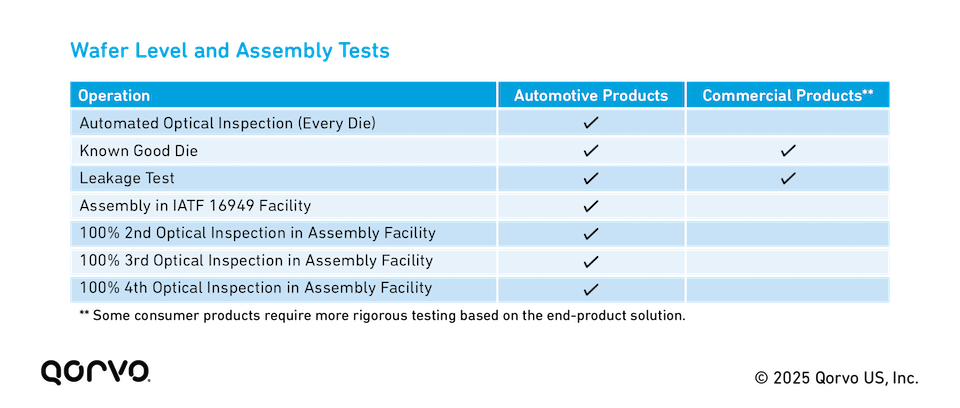
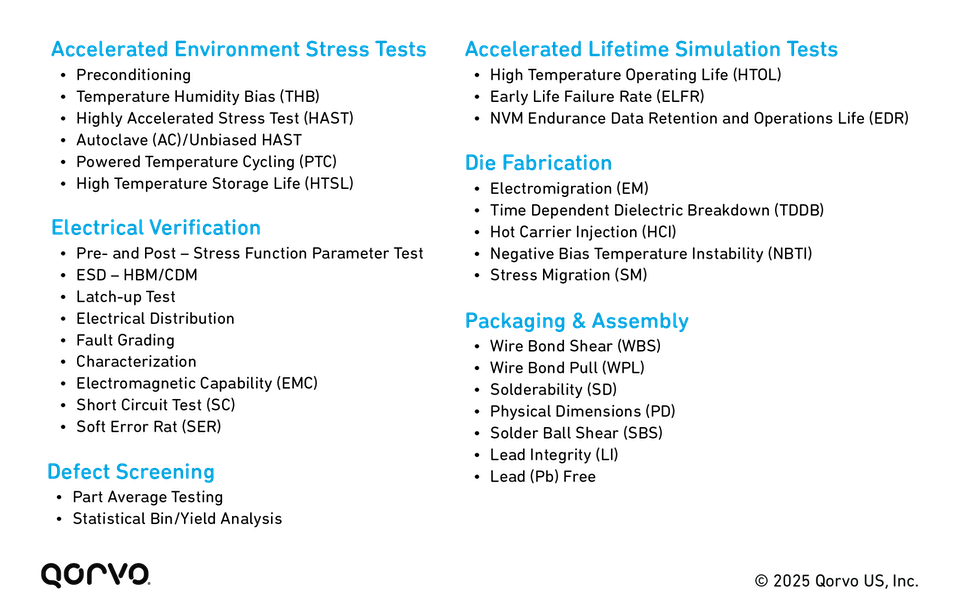
- Final Test, Tape and Reel: Despite the best manufacturing processes, there is always a risk that unexpected anomalies could result in early part failure. The automotive manufacturing process includes additional screening like final test, to identify and eliminate these "outlier" parts before they reach customers. .

- Reliability Testing and Documentation: Manufacturers must follow an extensive product quality program known as Advanced Product Quality Planning (APQP). This includes producing a detailed documentation package covering the entire manufacturing process, test records and a Failure Mode and Effect Analysis (FMEA). The Production Part Approval Process (PPAP) is a critical part of this program, ensuring that all components meet the necessary quality standards before they are approved for use in vehicles. .
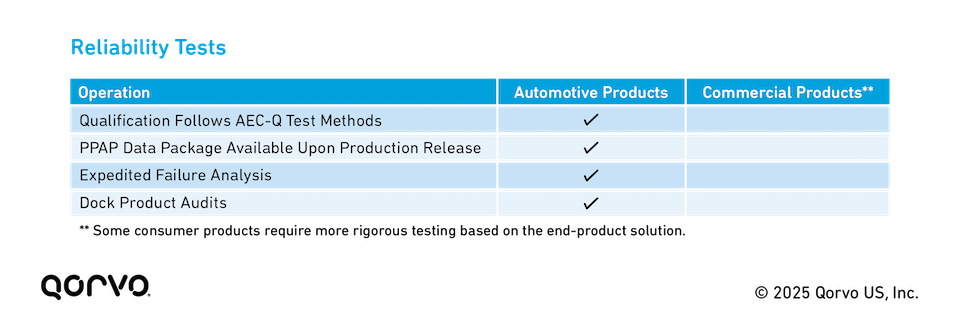
System-Level Certification
System-level certification is just as crucial as component-level certification, ensuring regulatory compliance, safety, and interoperability in automobiles. As vehicle systems become more complex, maintaining customer trust is essential. System reliability, especially for life-saving technologies, like passenger detection and automatic breaking, must meet the utmost requirements.
IATF 16949 addresses these system-level requirements, while ISO 26262 focuses on functional safety for automotive electrical and electronic systems, helping mitigate risks and protect passengers and road users. Additionally, SAE J2980 provides guidelines for evaluating the reliability of these systems, offering best practices for analysis, prediction and manufacturing of dependable automotive electronics.
As noted earlier, software-defined vehicles (SDVs) are the new norm as the automotive industry evolves. These SDVs, with their software-based safety applications, are becoming more common, increasing the risk of random hardware faults. An example is Child-Presence Detection, which uses Ultra-Wideband (UWB) ICs with embedded firmware to enhance safety.
ISO 26262 Functional Safety is a risk-based standard for electrical/electronic/programmable electronic systems in passenger vehicles. The standard helps assess hazardous situations, defines safety measures, and systematically aids in managing risks throughout the development process to prevent accidents caused by electronic malfunctions. This ensures high safety standards in modern vehicles with complex electronic systems.
The ISO 26262 standard classifies risks into four Automotive Safety Integrity Levels (ASILs) — ASIL A (lowest) to ASIL D (highest), with ASIL D requiring the most stringent safety measures. Table 6 below outlines the ASIL A to ASIL D safety standards while providing details on applicable use cases and the hazardous situation they aim to prevent.
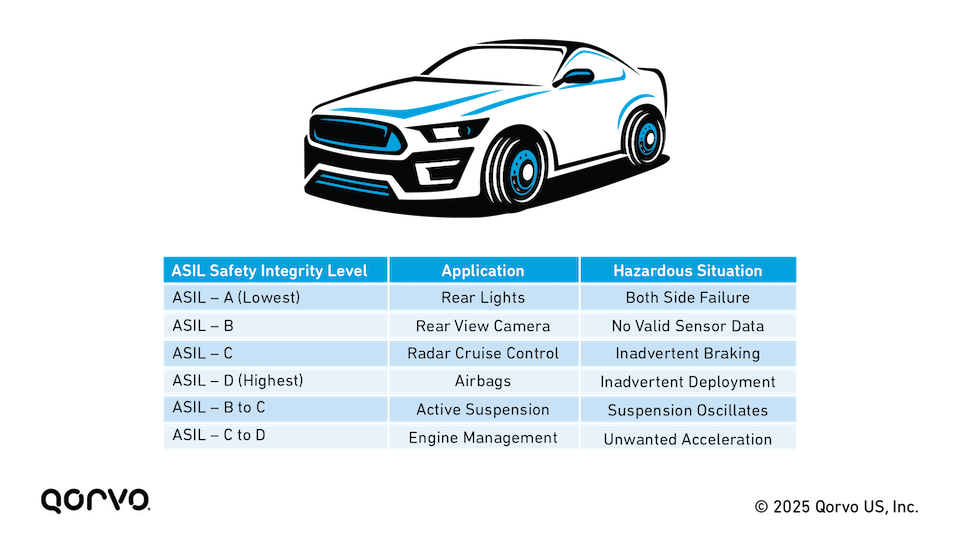
The Impact of Automotive Qualification
As vehicles increasingly resemble four-wheeled computing devices, the quality of electronic components becomes critical to both vehicle reliability and safety. While an RF filter, PMIC, or UWB IC qualified for automotive use may appear like a component designed for commercial use, the difference lies in the rigorous testing and manufacturing standards it must meet. Automotive-qualified components are built to withstand the rigors of real-world driving conditions over the many years a car will be on the road.
These standards ensure that automotive electronics are not just functional but are also durable and safe, capable of withstanding the extreme conditions they will encounter. As the automotive industry continues to evolve, the importance of adhering to these stringent qualification standards will only grow, ensuring that the vehicles of the future are as reliable and safe as possible.
A Final Word
Automotive qualification standards are essential in ensuring that the electronic components used in vehicles can meet the demanding requirements of the automotive environment. From ruggedness and reliability to longevity and interference management, these standards ensure that every component is built to last. As cars become more sophisticated and the electronic systems within them become more complex, adherence to these standards will remain crucial in maintaining the safety and reliability of vehicles on the road.
Additionally, you can find more interesting collateral on the subject by visiting our Qorvo Design Hub for a rich assortment of videos, technical articles, white papers, tools, and more.
For more information on this and other Qorvo automotive design solutions, please visit Qorvo.com or reach out to Technical Support.
About the Authors
Our authors bring a wealth of technical expertise in developing and optimizing wireless and wired solutions for vehicle applications. With a deep understanding of customer needs and industry trends, they collaborate closely with our design teams to drive innovation and deliver cutting-edge solutions that support industry-leading products.
Thank you to our main contributors to this article: Craig Callahan (VP Quality), Wade Cole (Sr. Director HPA & CSG Quality) and David Schnaufer (Corporate, Technical Marketing Manager) for their contributions to this blog post, ensuring our readers stay informed with expert knowledge and industry trends.
Have another topic that you would like Qorvo experts to cover? Email your suggestions to the Qorvo Blog team and it could be featured in an upcoming post. Please include your contact information in the body of the email.